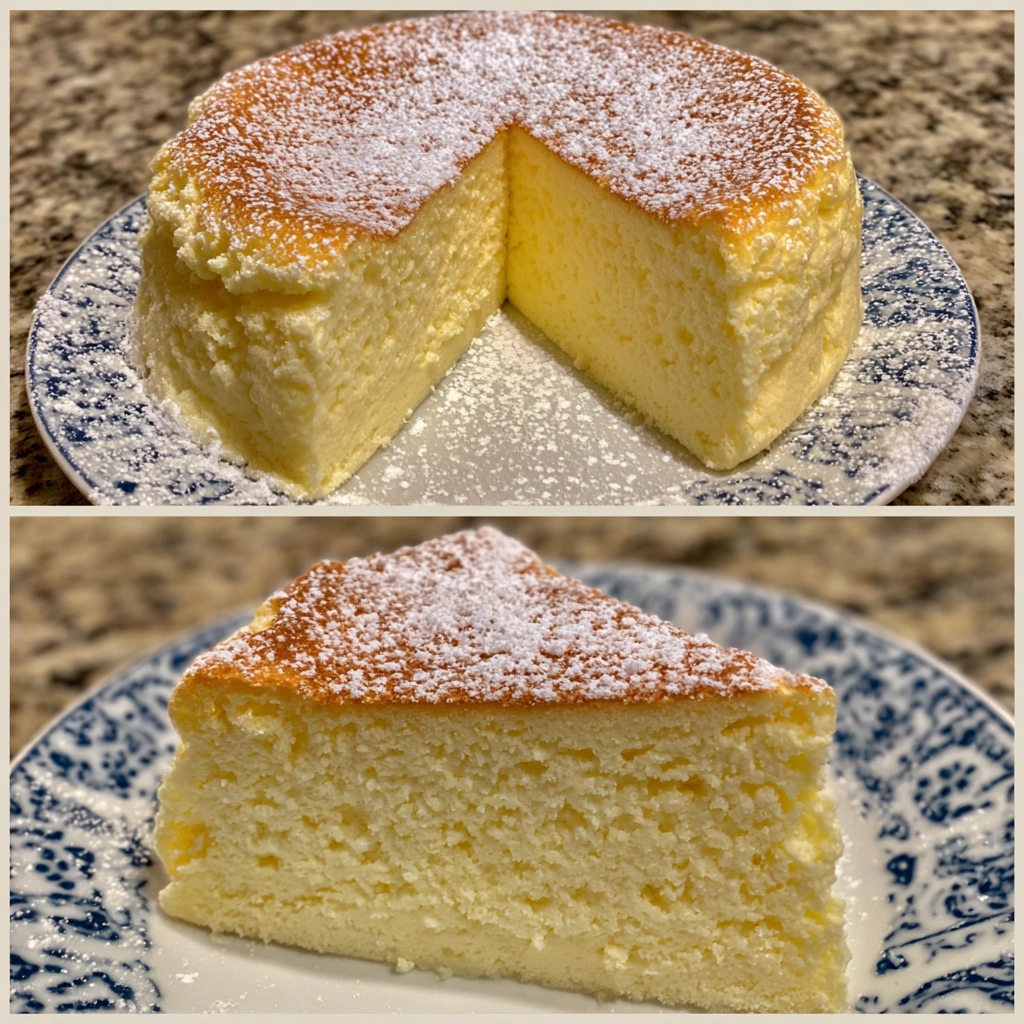Japanese Cotton Cheesecake has been my answer to a dessert that shines without weighing you down. I’m a professional chef behind Cook by Cook. I’m passionate about turning restaurant-worthy flavors into doable, weeknight-friendly recipes for busy women. Whether you’re balancing work, family, or personal goals, this fluffy cheesecake fits your life. It blends delicate technique with real-world practicality. You can wow loved ones or clients with something light, airy, and totally doable. If you’re exploring Japanese Recipe Ideas, this dessert sits near the top.
Table of Contents
what make this Japanese Cotton Cheesecake special
I adore Japanese Cotton Cheesecake for its cloud-light texture and gentle sweetness. It feels like a hug you can eat. The water-bath keeps it crack-free and tender, even on busy weeknights. It’s a crowd-pleaser that fits a tight schedule without sacrificing flavor.
Quick, airy appeal you can’t miss
The quick, airy appeal is instant. It melts softly, like a souffle with no heavy crust. You get a smile in every bite.
Why it fits your busy life
It fits your busy life because it can be planned ahead. You bake once, share later, and still feel proud.
How it showcases technique without overwhelm
This recipe shows technique without overwhelm. You whisk, fold, and bake in a water bath.
Why You’ll Love This Japanese Cotton Cheesecake
Light, not heavy
I adore its ultra-light texture that feels like a soft cloud on the palate. It delivers the wow factor without weighing you down, perfect after a busy day.
Impress with minimal fuss
With simple steps and a trusted water bath, you create restaurant-worthy dessert in a fraction of the time, and without stress. It’s surprisingly quick, too.
Flexible sweetness and texture
Adjust sugar or citrus to suit taste and dietary needs, while keeping that delicate, soufflé-like center intact.
Ingredients Japanese Cotton Cheesecake
Here are the exact ingredients for my Japanese Cotton Cheesecake. I keep explanations short so you know how each item helps create that cloud-light texture. Exact quantities are at the bottom of the article and available for printing.
- 7 oz cream cheese, softened — the creamy base that gives this cake its gentle tang and velvety texture.
- ¼ cup whole milk — adds moisture and helps emulsify the batter for a smooth finish.
- ¼ cup unsalted butter — adds richness and tenderness.
- ¼ cup all-purpose flour — provides structure and lift without weight.
- 2 tbsp cornstarch — helps keep the crumb extra soft and airy.
- ¼ tsp salt — balances sweetness and enhances flavor.
- 4 large eggs, separated — yolks build richness; whites become a fluffy meringue.
- ¼ tsp cream of tartar — stabilizes the egg whites for tall, firm peaks.
- ¼ cup granulated sugar — sweetens and stiffens the meringue.
- Powdered sugar for dusting (optional) — a pretty finish before serving.
Optional ingredients and substitutions
- Dairy-free version: use dairy-free cream cheese, ¼ cup almond milk (or oat milk) in place of whole milk, and dairy-free butter if needed.
- Bright note: add ½ teaspoon lemon zest to the yolk mixture for a gentle citrus lift.
- Alternate textures: swap in a touch of potato starch with 1–2 tablespoons if you like extra tenderness.
- Matcha twist: whisk ½–1 teaspoon matcha powder with the dry ingredients for a pale green bakery-style finish.
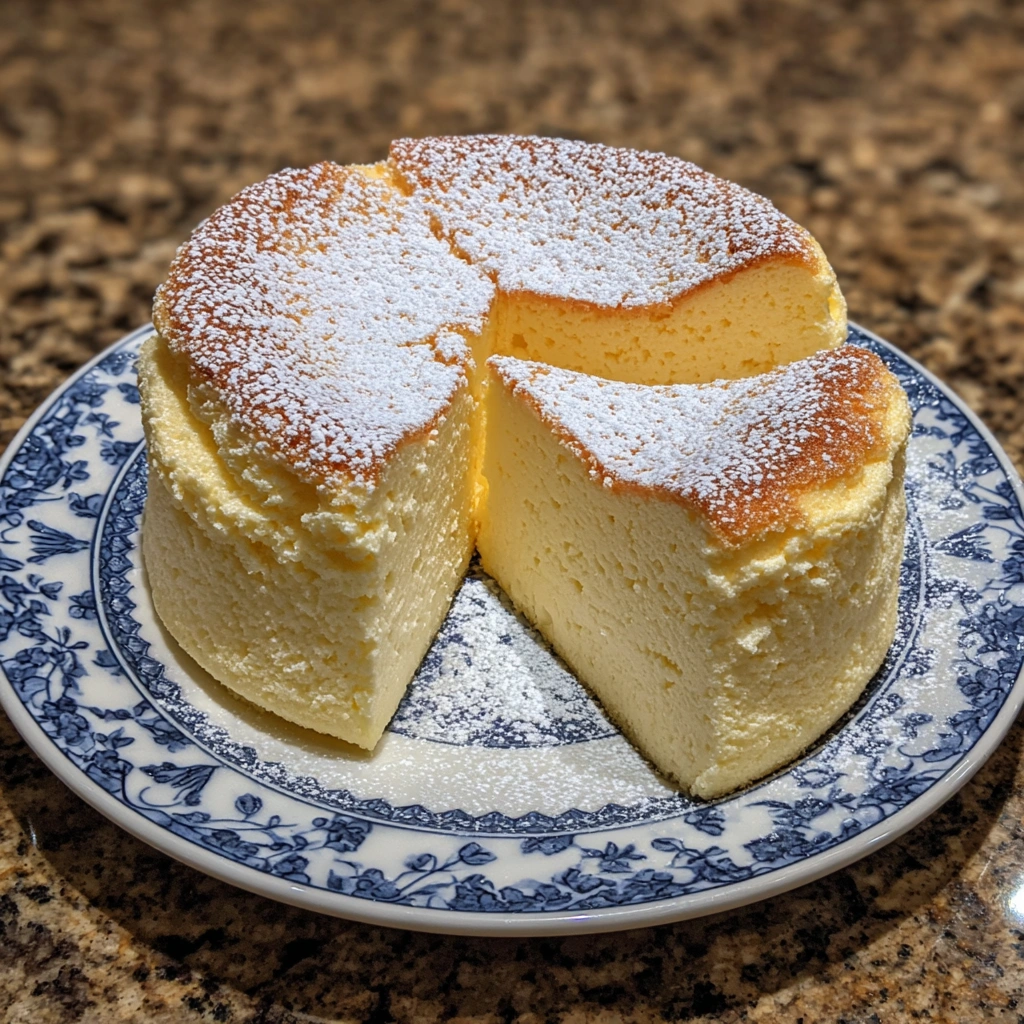
How to Make Japanese Cotton Cheesecake
Learning to make Japanese Cotton Cheesecake at home feels like teaching a shy souffle to speak. I’ll walk you through each step with simple, practical notes. This method keeps the cake light, airy, and forgiving enough for weeknight bakers. If you’re collecting Japanese Recipe Ideas, this technique is a keeper. You’ll see how the batter stays tender yet climbs tall in the oven. Let’s get our kitchen ready for a cloud you can slice.
Prep and heat for Japanese Cotton Cheesecake
Preheat to 320°F (160°C); line a 6-inch pan with parchment
First, I set up my station with calm focus. I preheat my oven to 320°F (160°C) and prepare my pan. Line a 6-inch round cake pan with parchment on the bottom and sides. If you have a favorite baking spray, light mist the parchment to help it cling. This little trick keeps slices neat. I keep the ingredients within reach so I can stay in rhythm. Doing this upfront saves time when the batter comes together. If you’re collecting Japanese Recipe Ideas, this prep routine shines. It smells like promise and sets the stage for a cloud-like cake.
Next, I gather tools and ingredients in one comfortable line. The aim is simplicity that doesn’t stall flavor. By the time you read this, you’ll feel confident starting the batter without hunting for items. A tidy station makes the first whisk feel almost fun. And yes, this is the moment your kitchen earns its dessert crown.
Tip: keep the dairy room-temperature if you can. It helps emulsify smoothly and gives you a kinder crumb. Patience here pays off once the batter comes together.
Step: Melt and emulsify for Japanese Cotton Cheesecake
Melt cream cheese, butter, and milk over gentle heat; whisk until smooth
Meanwhile, I melt cream cheese, butter, and milk over a gentle simmer. I use a double boiler to keep the heat soft and steady. I stir until the mixture is silky smooth and uniform. I remove it from heat and let it cool slightly so eggs won’t scramble later. This cooling step is tiny but mighty. Then I whisk in the dry ingredients—flour, cornstarch, and salt—until smooth. No lumps, no drama. I rest the mixture briefly to keep the batter calm. This base is the heart of the cake and worth the wait.
This base is the backbone you’ll lean on as you build the light, airy texture. If you’re exploring Japanese Recipe Ideas, you’ll find this emulsified foundation pays off in other desserts too. Keep a steady pace here; speed isn’t the goal, smoothness is.
Let the bowl rest for a moment while you prepare the next stage. A calm workflow helps you glide through the rest of the recipe. You’re doing fine, promise. The next step brings the yolk richness into play while keeping the mix tender.
Step: Dry mix and yolk incorporation for Japanese Cotton Cheesecake
Sift in flour, cornstarch, salt; cool slightly; whisk in yolks one by one
First, I sift flour, cornstarch, and salt into the warm base. The dry mix should land softly, not in a clump. I let the mixture cool slightly so the yolks won’t cook. Then I whisk in yolks one by one, letting each blend in before the next goes in. The batter should look glossy and feel smooth. If it thickens too fast, give it a gentle stir and a moment to rest. I keep the pace steady so the batter remains airy.
Drop in the yolk one at a time, watching the texture transform. This is where the cheesecake gains its lift without losing tenderness. It’s a small dance with the batter, but a crucial one. Remember, this is your chance to shape the final cloud.
If you’re compiling Japanese Recipe Ideas, this yolk incorporation is a dependable technique you can reuse. It keeps the batter rich without weighting it down. You’ve earned a moment of kitchen confidence right here.
Step: Make the meringue for Japanese Cotton Cheesecake
Beat whites with cream of tartar until foamy; gradually add sugar to stiff peaks
Now I turn to the meringue. I beat egg whites with a pinch of cream of tartar until foamy. Then I slow-add sugar, a little at a time, until stiff peaks form. The goal is glossy, tall peaks that hold their shape. This airy foam is the secret lift behind the cloud-like center. I avoid overbeating, which can dry the whites and weigh down the batter. Patience here keeps the texture light and springy.
The meringue should look snowy and stable. If it slides or deflates, you’ve overmixed. Fold with care in the next step to preserve that airiness. This is where the magic stays intact.
Step: Fold with care for Japanese Cotton Cheesecake
Gently fold the meringue into yolk mixture in 3 additions, preserving air
Gently fold the meringue into the yolk mixture in three additions. I rotate the bowl and lift with a rubber spatula, slicing through the center and turning the batter as I go. The aim is to keep the batter airy, not paste-like. If you see deflation, slow down and fold lighter. The batter should look pale, glossy, and full of life after each fold.
Three additions keep the mix even and the air intact. I’m careful not to overwork it. The cake will rise higher and stay tender because we protected those air pockets. This step makes a big difference in the final texture. It’s worth a quiet, careful approach.
For readers chasing Japanese Recipe Ideas, this folding method is a lifesaver. It translates well to other delicate batters, maintaining volume while staying gentle with structure. You’re doing great—stay steady.
Step: Bake in water bath for Japanese Cotton Cheesecake
Pour into pan, place in larger pan with ~1 inch hot water; bake 70–75 minutes; turn off oven and rest 10 minutes with door ajar
Pour the batter into the prepared pan. I tap the pan gently to release any large air bubbles. Then I set the cake in a larger pan with about 1 inch of hot water. The water bath is my best friend here; it keeps cracks away and helps the cake rise evenly. I bake for 70–75 minutes, watching for a gentle jiggle in the center. When done, I turn off the oven and leave the door ajar for 10 minutes. This rest lowers the risk of cracking as it cools.
If you’re new to this technique, think of the water bath as a slow, steady hug for your cheesecake. It’s the reason you’ll get that dreamy, cloud-like interior. And yes, this is exactly how the pros keep it tall and tender.
Step: Cool and finish for Japanese Cotton Cheesecake
Remove from water bath, cool completely, dust with powdered sugar if desired
After the oven rest, I remove the cake from the water bath and cool it completely on a rack. This cooling step prevents sogginess and helps the slices hold their neat shape. I dust with powdered sugar for a pretty finish, if desired. I slice only once fully cooled to maintain clean edges. If you want, a brief chill in the fridge gives you sharper cuts and a polished presentation.
And there you have it—the tender, airy heart of a Japanese Cotton Cheesecake. The technique rewards patience and a gentle touch, but it’s still doable at home. This dessert pairs beautifully with bright tea or a sparkling treat, and it’s sure to impress without weighing you down. Enjoy the lightness, embrace the process, and savor every cloud-like bite.
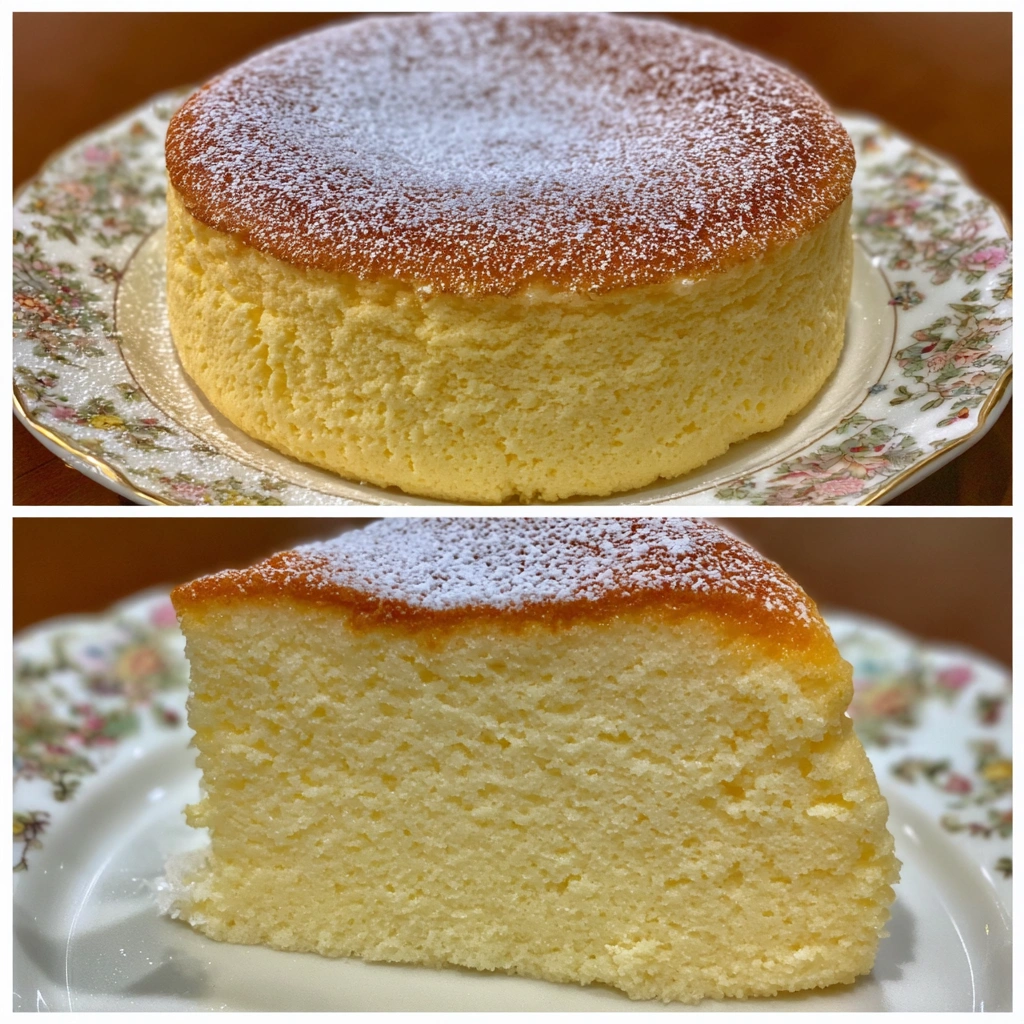
Tips for Success
- Use room-temperature ingredients for a smoother batter, especially cream cheese and eggs, when making Japanese Cotton Cheesecake, to keep emulsions seamless.
- Fold the meringue into yolks in three additions to preserve air and height.
- Tap the filled pan to release bubbles before baking, reducing craters and cracks.
- Be gentle with mixing; resist the urge to overwork the batter and deflate it.
- Let the cake cool completely before slicing for neat, clean portions.
Equipment Needed
- 6-inch round cake pan, parchment-lined for easy release (or foil sling if you’re improvising).
- Medium heatproof bowl and a pot for a simple, gentle double boiler.
- Electric mixer or whisk.
- Spatula and rubber scraper for folding.
- Large baking pan for water bath (roasting pan works in a pinch).
- Cooling rack to cool and slice neatly.
Variations
- Lemon zest or orange zest for a bright citrus note. I add 1/2 teaspoon zest to the yolk mixture for a sunny lift in Japanese Cotton Cheesecake.
- Dairy-free version: use dairy-free cream cheese, almond milk (or oat milk), and dairy-free butter. This keeps the texture light and airy for dairy-free eaters.
- Matcha-infused batter: whisk 1–2 teaspoons matcha powder with the dry ingredients. It gives a pale green, cafe-worthy twist to the cloud-light center.
- Lower-sugar option: reduce sugar by 1–2 tablespoons and add a touch of vanilla. Your Japanese Cotton Cheesecake stays tender with gentler sweetness.
Serving Suggestions
- Dust with extra powdered sugar and berries on Japanese Cotton Cheesecake slices
- Serve with a light floral tea or sparkling rosé
- Plate on a white cake stand for an elegant presentation
- Slice after fully cooled for neat portions
- Pair with a bright citrus tea to cut sweetness
- Garnish slices with a lemon twist or fresh mint
Make It Your Own: Flavor, Pairings, and Presentation
This is where I tailor Japanese Cotton Cheesecake to fit your life. Its cloud-light texture invites playful flavor work without losing lift. Here are ideas for flavor, pairings, and presentation that suit busy weeks and weekend gatherings.
Flavor ideas to tailor your cloud
- Citrus lift: add lemon zest or yuzu for a bright, clean finish.
- Matcha whisper: fold in 1/2 teaspoon matcha with the dry ingredients.
- Chocolate kiss: whisk in 1–2 tablespoons cocoa powder for a gentle swirl.
- Berries in bloom: a decorative berry compote or a ribbon of berry puree folded in.
- Vanilla glow: a splash of vanilla and a tiny pinch of almond extract for warmth.
Pairings that elevate the experience
- Tea pairing: green tea, hojicha, or Earl Grey enhance the delicate sweetness.
- Light bubbles: a glass of sparkling rosé or a crisp sparkling water with citrus.
- Fruit accents: a handful of fresh berries or sliced stone fruit on the side.
- Whipped accoutrements: a dollop of lightly sweetened whipped cream or mascarpone.
Presentation tips that wow
- Slice after full cooling for clean, neat portions.
- Dust with powdered sugar and arrange on a white plate for contrast.
- Garnish with mint, edible flowers, or citrus zest curls for a fresh look.
- Serve on a cake stand to make it feel special without extra effort.
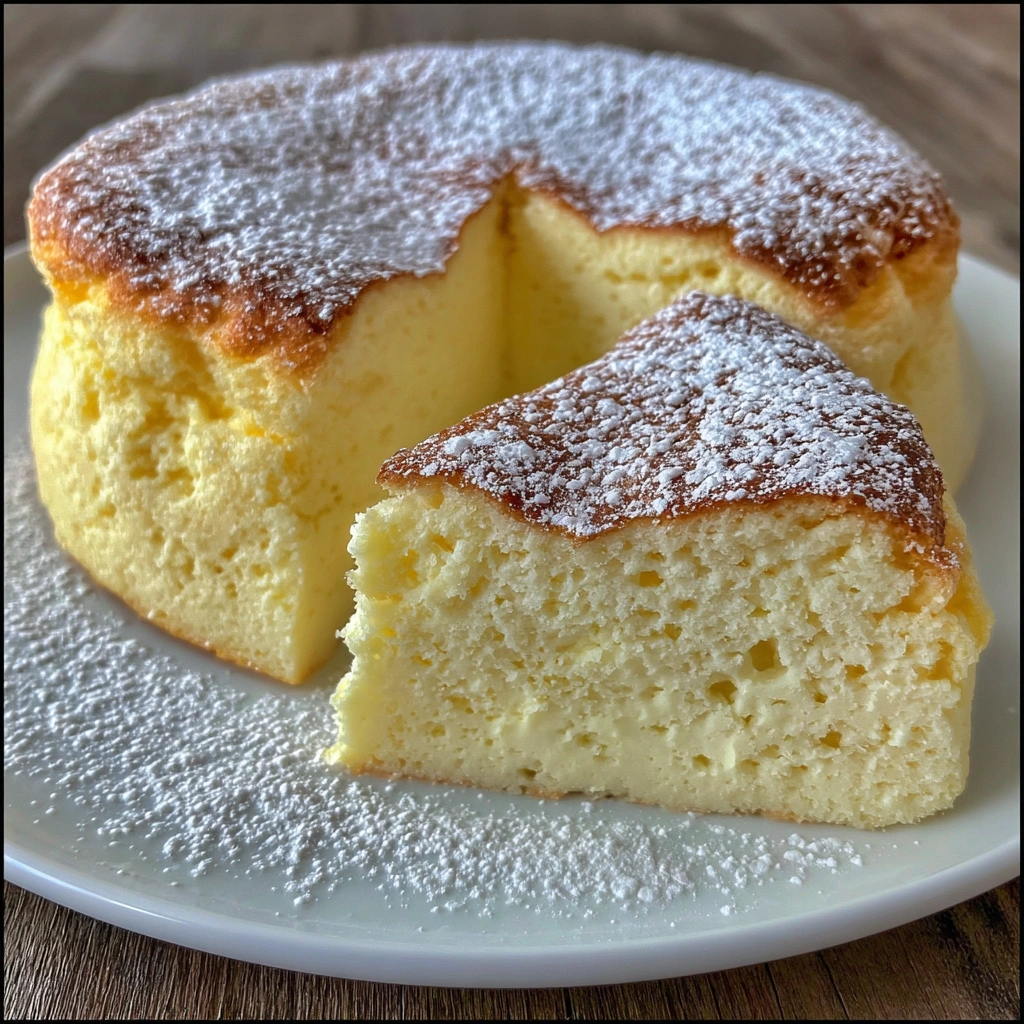
Dietary tweaks and batch planning
- Gluten-free option: use a 1:1 gluten-free flour blend; texture stays light.
- Dairy-free version: swap to dairy-free cream cheese and plant milk; keep airiness with careful folding.
- Make-ahead: bake, cool, wrap well, and refrigerate up to 2–3 days; freeze slices for longer storage.
With these ideas, your Japanese Cotton Cheesecake becomes a personalized, crowd-pleasing dessert that fits real life—with style and ease.
FAQs
What does Japanese Cotton Cheesecake taste like?
Japanese Cotton Cheesecake tastes light and airy with delicate sweetness and a custard-like interior, unlike dense traditional cheesecakes. I find it feels like a gentle cloud you can slice. If you’re exploring Japanese Recipe Ideas, this dessert is a gentle, crowd-pleasing starting point.
How is Japanese cotton cheesecake different from regular cheesecake?
It’s soufflé-like, with a moist, jiggle-y center and a pale crust. It uses meringue folded into a yolk batter and is baked in a water bath for height and stability. This is what differentiates Japanese Cotton Cheesecake from regular cheesecake. If you’re exploring Japanese Recipe Ideas, this technique fits right in.
Can I make this dairy-free?
Yes. Swap dairy ingredients for dairy-free options (cream cheese substitute, plant milk, and dairy-free butter). The texture stays light with careful folding. This dairy-free version is a great addition to your Japanese Recipe Ideas toolkit for entertaining friends who avoid dairy.
How long will it keep?
Best eaten within 2–3 days kept covered in the fridge; serve chilled or at room temperature for a softer texture. If you bake ahead for a crowd, this fits well with your week.
Do I need a water bath?
Yes. A water bath helps prevent cracks and keeps the cake airy and tidy. If you’re collecting Japanese Recipe Ideas, you’ll see how this technique shows up in other desserts too.
Final Thoughts
This Japanese Cotton Cheesecake reminds me that lightness can be a virtue in a busy kitchen. I love how a little technique, patience, and a gentle touch turn simple ingredients into something elegant yet practical. When I slice into it after a calm cooling, the center stays tender and jiggles just enough to make me smile. It’s a dessert you can share with friends, family, or clients without feeling overwhelmed. If you’re chasing weeknight wow without weight, this cloud-light cheesecake delivers—and it leaves you confident, ready for the next tasty challenge. May your evenings end softly with a satisfied sigh.
Print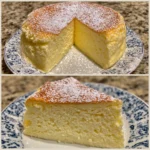
Japanese Cotton Cheesecake: 7 Fluffy, Delicious, Airy Tips.
- Total Time: 1 hour 35 minutes
- Yield: 5 servings 1x
- Diet: Vegetarian
Description
Japanese Cotton Cheesecake: Light, fluffy, and jiggly, this melt-in-your-mouth dessert is an airy soufflé-like cheesecake that wows with its soft texture and delicate flavor.
Ingredients
- 7 oz cream cheese, softened
- ¼ cup whole milk
- ¼ cup unsalted butter
- ¼ cup all-purpose flour
- 2 tbsp cornstarch
- ¼ tsp salt
- 4 large eggs, separated
- ¼ tsp cream of tartar
- ¼ cup granulated sugar
- Powdered sugar for dusting (optional)
Instructions
- Preheat oven to 320°F (160°C). Line the bottom and sides of a 6-inch round cake pan with parchment paper.
- In a heatproof bowl over a pot of simmering water, melt cream cheese, butter, and milk together. Stir until smooth and remove from heat.
- Sift in flour, cornstarch, and salt. Whisk until well combined. Let cool slightly.
- Add egg yolks one at a time, whisking gently after each addition. Set aside.
- In a clean bowl, beat egg whites with cream of tartar until foamy. Gradually add sugar and continue beating until stiff peaks form.
- Gently fold the meringue into the yolk mixture in three parts, being careful not to deflate the batter.
- Pour the batter into the prepared pan and tap gently to remove air bubbles.
- Place the cake pan into a larger pan filled with about 1 inch of hot water (water bath).
- Bake for 70–75 minutes, then turn off the oven and let the cake sit inside for 10 minutes with the door slightly ajar.
- Remove, cool completely, and dust with powdered sugar before serving.
Notes
- Bake in a water bath to help prevent cracks and keep the cheesecake ultra-tidy and airy.
- Use room-temperature ingredients for a smoother, more stable batter.
- Fold the meringue into the yolk mixture in three parts to avoid deflating the batter.
- Let the cake cool completely before slicing for clean, delicate slices.
- Dust with powdered sugar just before serving for a pretty finish.
- Yields about 5 servings.
- Prep Time: 20 minutes
- Cook Time: 1 hour 15 minutes
- Category: Dessert
- Method: Baked
- Cuisine: Japanese
Nutrition
- Serving Size: 1 slice (about 1/5 of cake)
- Calories: Approximately 380 kcal
- Sugar: Approximately 10 g
- Sodium: Approximately 650 mg
- Fat: Approximately 26 g
- Saturated Fat: Approximately 12–14 g
- Unsaturated Fat: Approximately 12–14 g
- Trans Fat: 0–1 g
- Carbohydrates: Approximately 20 g
- Fiber: 0 g
- Protein: Approximately 8 g
- Cholesterol: Approximately 170 mg
Keywords: Japanese Cotton Cheesecake, Japanese Recipe Ideas
